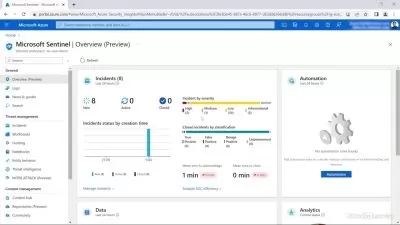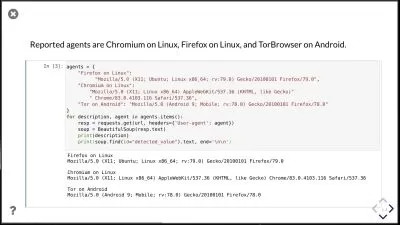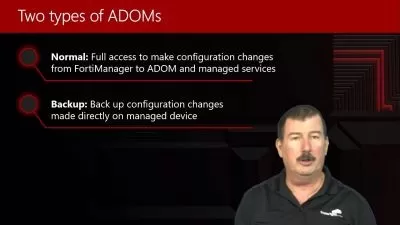Introduction To Securing Networks and Its Devices
Lazaro Diaz
2:02:36
Description
Essential Strategies for Protecting Networks and Devices from Cyber Threats
What You'll Learn?
- Understand Fundamental Network Security Concepts Gain a solid grasp of core network security principles, including confidentiality, integrity, and availability
- Identify and Mitigate Common Network Threats Learn to recognize various network threats and vulnerabilities, such as malware, phishing, and DDoS attacks
- Secure Network Devices through Configuration and Best Practices Acquire practical skills in configuring routers, switches, and firewalls
- Implement Security Protocols and Monitoring Tools Apply security protocols like SSL/TLS and use monitoring tools to detect, respond to
Who is this for?
What You Need to Know?
More details
DescriptionIn an era where cyber threats are increasingly sophisticated, securing networks and their devices has become paramount for organizations and individuals alike. Introduction to Securing Networks and Its Devices is a comprehensive course designed to provide you with the foundational knowledge and practical skills necessary to safeguard network infrastructures effectively.
This course begins by exploring the fundamental concepts of network security, including the principles of confidentiality, integrity, and availability. You will gain insights into the various types of network architectures and understand how data flows within these systems. By grasping these basics, you'll be better prepared to identify potential vulnerabilities and implement appropriate security measures.
We delve into common network threats such as malware, phishing attacks, and Distributed Denial of Service (DDoS) attacks. You'll learn how to recognize these threats and understand their impact on network performance and security. The course emphasizes proactive strategies to mitigate risks, including the implementation of firewalls, intrusion detection systems, and antivirus solutions.
Hands-on modules guide you through the configuration of network devices like routers and switches using industry best practices. You'll acquire practical skills in setting up secure network protocols, managing user access controls, and enforcing security policies. The course also covers essential security protocols like SSL/TLS, teaching you how to establish encrypted communications to protect data integrity and privacy.
Monitoring and incident response are crucial components of network security. You'll be introduced to various tools and techniques for real-time network monitoring, enabling you to detect and respond to security incidents promptly. By the end of the course, you'll have a solid understanding of how to develop and implement a robust network security plan.
Whether you're an aspiring network administrator, a cybersecurity enthusiast, or an IT professional seeking to enhance your skill set, this course offers valuable insights into the world of network security. With a blend of theoretical knowledge and practical application, you'll be equipped to tackle real-world security challenges and contribute to creating a safer digital environment.
Join us on this journey to empower yourself with the essential strategies and tools needed to protect networks and devices from ever-evolving cyber threats.
Who this course is for:
- Familiarity with Operating Systems A basic proficiency in using operating systems like Windows and Linux is recommended, as the course may involve configuring security settings and network configurations on these platforms.
In an era where cyber threats are increasingly sophisticated, securing networks and their devices has become paramount for organizations and individuals alike. Introduction to Securing Networks and Its Devices is a comprehensive course designed to provide you with the foundational knowledge and practical skills necessary to safeguard network infrastructures effectively.
This course begins by exploring the fundamental concepts of network security, including the principles of confidentiality, integrity, and availability. You will gain insights into the various types of network architectures and understand how data flows within these systems. By grasping these basics, you'll be better prepared to identify potential vulnerabilities and implement appropriate security measures.
We delve into common network threats such as malware, phishing attacks, and Distributed Denial of Service (DDoS) attacks. You'll learn how to recognize these threats and understand their impact on network performance and security. The course emphasizes proactive strategies to mitigate risks, including the implementation of firewalls, intrusion detection systems, and antivirus solutions.
Hands-on modules guide you through the configuration of network devices like routers and switches using industry best practices. You'll acquire practical skills in setting up secure network protocols, managing user access controls, and enforcing security policies. The course also covers essential security protocols like SSL/TLS, teaching you how to establish encrypted communications to protect data integrity and privacy.
Monitoring and incident response are crucial components of network security. You'll be introduced to various tools and techniques for real-time network monitoring, enabling you to detect and respond to security incidents promptly. By the end of the course, you'll have a solid understanding of how to develop and implement a robust network security plan.
Whether you're an aspiring network administrator, a cybersecurity enthusiast, or an IT professional seeking to enhance your skill set, this course offers valuable insights into the world of network security. With a blend of theoretical knowledge and practical application, you'll be equipped to tackle real-world security challenges and contribute to creating a safer digital environment.
Join us on this journey to empower yourself with the essential strategies and tools needed to protect networks and devices from ever-evolving cyber threats.
Who this course is for:
- Familiarity with Operating Systems A basic proficiency in using operating systems like Windows and Linux is recommended, as the course may involve configuring security settings and network configurations on these platforms.
User Reviews
Rating
Lazaro Diaz
Instructor's Courses
Udemy
View courses Udemy- language english
- Training sessions 11
- duration 2:02:36
- Release Date 2025/01/24








